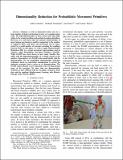Por favor, use este identificador para citar o enlazar a este item:
http://hdl.handle.net/10261/127335COMPARTIR / EXPORTAR:
 SHARE
BASE SHARE
BASE
|
|
| Visualizar otros formatos: MARC | Dublin Core | RDF | ORE | MODS | METS | DIDL | DATACITE | |

| Campo DC | Valor | Lengua/Idioma |
|---|---|---|
| dc.contributor.author | Colomé, Adrià | - |
| dc.contributor.author | Neumann, Gerhard | - |
| dc.contributor.author | Peters, Jan | - |
| dc.contributor.author | Torras, Carme | - |
| dc.date.accessioned | 2016-01-07T11:31:27Z | - |
| dc.date.available | 2016-01-07T11:31:27Z | - |
| dc.date.issued | 2014 | - |
| dc.identifier.citation | 14th IEEE-RAS International Conference on Humanoid Robots (Humanoids): 794-800 (2014) | - |
| dc.identifier.uri | http://hdl.handle.net/10261/127335 | - |
| dc.description | Trabajo presentado al 14th IEEE-RAS International Conference on Humanoid Robots: Humanoids 2014 "Humans and Robots Face-to-Face", celebrado en Madrid (España) del 18 al 20 de noviembre de 2014. | - |
| dc.description.abstract | Humans as well as humanoid robots can use a large number of degrees of freedom to solve very complex motor tasks. The high-dimensionality of these motor tasks adds difficulties to the control problem and machine learning algorithms. However, it is well known that the intrinsic dimensionality of many human movements is small in comparison to the number of employed DoFs, and hence, the movements can be represented by a small number of synergies encoding the couplings between DoFs. In this paper, we want to apply Dimensionality Reduction (DR) to a recent movement representation used in robotics, called Probabilistic Movement Primitives (ProMP). While ProMP have been shown to have many benefits, they suffer with the high-dimensionality of a robotic system as the number of parameters of a ProMP scales quadratically with the dimensionality. We use probablistic dimensionality reduction techniques based on expectation maximization to extract the unknown synergies from a given set of demonstrations. The ProMP representation is now estimated in the low-dimensional space of the synergies. We show that our dimensionality reduction is more efficient both for encoding a trajectory from data and for applying Reinforcement Learning with Relative Entropy Policy Search (REPS). | - |
| dc.description.sponsorship | This work is partially funded by CSIC Project MANIPlus (201350E102). Adrià Colomé is also supported by the Spanish Ministry of Education, Culture and Sport via a FPU doctoral grant (AP2010-1989). | - |
| dc.publisher | Institute of Electrical and Electronics Engineers | - |
| dc.relation.isversionof | Postprint | - |
| dc.rights | openAccess | - |
| dc.title | Dimensionality reduction for probabilistic movement primitives | - |
| dc.type | comunicación de congreso | - |
| dc.identifier.doi | 10.1109/HUMANOIDS.2014.7041454 | - |
| dc.relation.publisherversion | http://dx.doi.org/10.1109/HUMANOIDS.2014.7041454 | - |
| dc.date.updated | 2016-01-07T11:31:27Z | - |
| dc.description.version | Peer Reviewed | - |
| dc.language.rfc3066 | eng | - |
| dc.contributor.funder | Consejo Superior de Investigaciones Científicas (España) | - |
| dc.contributor.funder | Ministerio de Educación, Cultura y Deporte (España) | - |
| dc.relation.csic | Sí | - |
| dc.identifier.funder | http://dx.doi.org/10.13039/501100003339 | es_ES |
| dc.identifier.funder | http://dx.doi.org/10.13039/501100003176 | es_ES |
| dc.type.coar | http://purl.org/coar/resource_type/c_5794 | es_ES |
| item.openairetype | comunicación de congreso | - |
| item.grantfulltext | open | - |
| item.cerifentitytype | Publications | - |
| item.openairecristype | http://purl.org/coar/resource_type/c_18cf | - |
| item.fulltext | With Fulltext | - |
| Aparece en las colecciones: | (IRII) Comunicaciones congresos | |
Ficheros en este ítem:
| Fichero | Descripción | Tamaño | Formato | |
|---|---|---|---|---|
| Movement-Primitives.pdf | 973,41 kB | Adobe PDF |  Visualizar/Abrir |
CORE Recommender
Page view(s)
239
checked on 18-abr-2024
Download(s)
295
checked on 18-abr-2024
Google ScholarTM
Check
Altmetric
Altmetric
NOTA: Los ítems de Digital.CSIC están protegidos por copyright, con todos los derechos reservados, a menos que se indique lo contrario.
